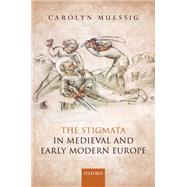The Stigmata in Medieval and Early Modern Europe
, by Muessig, Carolyn- ISBN: 9780198795643 | 0198795645
- Cover: Hardcover
- Copyright: 3/6/2020
Francis of Assisi's reported reception of the stigmata on Mount La Verna in 1224 is often considered to be the first account of an individual receiving the five wounds of Christ. The thirteenth-century appearance of this miracle, however, is not as unexpected as it first seems. Interpretations of Galatians 6:17-I bear the stigmata of the Lord Jesus Christ in my body-had been circulating in biblical commentaries since late antiquity. These works explained stigmata as wounds that martyrs, like the apostle Paul, received in their attempt to spread Christianity in the face of resistance. By the seventh century, stigmata were described as marks of Christ that priests received invisibly at their ordination. In the eleventh century, monks and nuns were perceived as bearing the stigmata in so far as they lived a life of renunciation out of love for Christ. By the later Middle Ages, women (such as Catherine of Siena) were described as having stigmata more frequently than were men. With the religious upheavals of the sixteenth century, the way stigmata were defined reflected the diverse perceptions of Christianity held by Catholics and Protestants.







